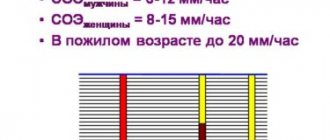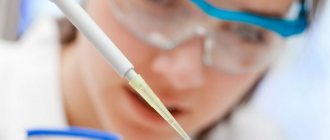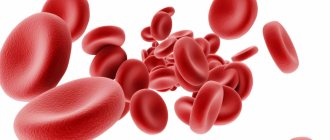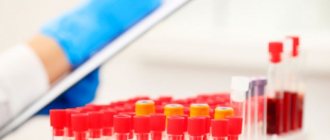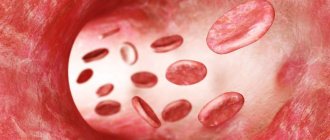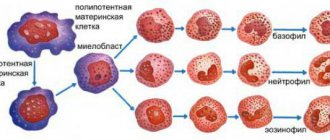Lactate dehydrogenase (LDH) is an intracellular enzyme involved in glucose metabolism. Contains zinc and is produced by all cells of the body.
The greatest activity of the enzyme is observed in muscles, heart, liver, kidneys and blood cells - red blood cells.
There are 5 types of LDH; the predominance of one or another type of enzyme determines the method of glucose metabolism in tissues - aerobic (to carbon dioxide and water) or anaerobic (to lactic acid). For example, LDH-1 predominates in the myocardium, LDH-2 predominates in the kidneys and blood cells, LDH-3 and 4 predominate in most internal organs, and LDH-5 predominates in muscles, placenta, and liver. All forms of the enzyme are present in the blood, where they are determined as part of the total indicator - total lactate dehydrogenase.
The concentration of LDH in the blood increases in diseases characterized by damage to body tissues. A blood test for LDH is not specific, but in combination with other tests it helps to diagnose various pathological conditions: pulmonary infarction, hemolytic anemia, etc. When diagnosing myocardial infarction, the analysis is used as an auxiliary test in the case of pain in the chest. In the presence of a heart attack, LDH activity increases, while during angina attacks the indicator does not change. The level of LDH in the blood can increase even in the presence of malignant tumors and decreases with their effective treatment, which allows the test to be used for dynamic monitoring of cancer patients.
Distribution of fractions in plasma. Age and norm
content of LDH fractions in organs
The first fraction (LDH-1 or HHNN tetramer) originates primarily in the cardiac muscle and is significantly increased in the blood serum with myocardial damage.
The second, third, fourth fractions (LDG-2, LDH-3, LDH-4) begin to actively enter the plasma under pathological conditions accompanied by massive death of blood platelets - platelets, which occurs, for example, in the case of such a life-threatening condition as pulmonary embolism (PE).
The fifth isoenzyme (LDG-5 or MMMM tetramer) comes from the cells of the liver parenchyma and is released into the blood plasma in large quantities at the acute stage of viral hepatitis.
Due to the fact that different types of tissue accumulate and release different concentrations of LDH, fractions of lactate dehydrogenase isoenzymes are distributed unevenly in the blood plasma:
| Isoenzyme | Serum concentration |
| LDH-1 | 17 – 27% (0.17 – 0.27 relative units) |
| LDG-2 | 27 – 37% (0,27 – 0,37) |
| LDG-3 | 18 – 25% (0,18 – 0,25) |
| LDG-4 | 3 – 8% (0,03 – 0,08) |
| LDG-5 | 0 – 5% (0,00 – 0,05) |
The activity of lactate dehydrogenase in red blood cells (erythrocytes) is 100 times higher than the levels of the enzyme contained in the blood plasma, and increased values are observed not only in pathological conditions, but also in a number of physiological conditions, for example, pregnancy, the first months of life or excessive physical effort on their part also contribute to an increase in LDH activity. Significant differences in the normal levels of this indicator are also due to age and gender, as evidenced by the table below:
| Age | Normal indicators (U/l, 37°C) |
| Newborns | 150 — 785 |
| From 1 month to six months | 160 — 437 |
| From 7 months to a year of life | 145 — 365 |
| From 1 year to 2 years | 86 -305 |
| From 3 to 16 years | 100 — 290 |
| Adult Women Men | 120 – 214 135 — 240 |
Meanwhile, the normal values for blood LDH are always approximate; they should not be memorized once and for all for the reason that the analysis can be performed at a temperature of 30°C or 37°C, the level is calculated in different units (μkat/l, mmol/( h·l), U/l or U/l). But if there is an urgent need to independently compare your own results with the normal variants, then it will be useful to first inquire about the institution that performed the analysis, the methods of its implementation and the units of measurement used by this laboratory.
Excretion of lactate dehydrogenase isoenzymes (LDH-4, LDH-5) by the kidneys does not exceed the level of 35 mg/day (excretion rate).
Reasons for increased LDH
The level of LDH activity is increased in almost any pathological process that is accompanied by inflammation and death of cellular structures, therefore the reasons for the increase in this indicator are primarily considered to be:
- Acute phase of myocardial infarction (a more detailed description of changes in the LDH spectrum during necrotic myocardial damage will be presented below);
- Functional failure of the cardiac and vascular system, as well as the respiratory system (lungs). Involvement of lung tissue in the process and the development of circulatory failure in the pulmonary circulation (LDH levels are increased due to the activity of LDH-3 and, to some extent, due to LDH-4 and LDH-5). Weakening of cardiac activity leads to circulatory disorders, symptoms of congestion and an increase in the activity of LDH-4 and LDH-5 fractions;
- Damage to red blood cells (pernicious and hemolytic anemia), causing a state of tissue hypoxia;
- Inflammatory processes affecting the lungs, as well as the renal or hepatic parenchyma;
- Pulmonary embolism, pulmonary infarction;
- Acute period of viral hepatitis (in the chronic stage, LDH activity, as a rule, does not leave the normal range);
- Malignant tumors (especially those with metastasis), localized mainly in the liver tissue. Meanwhile, a strict correlation, in contrast to myocardial infarction (the larger the size of the lesion, the higher the activity of LDH) between the progression of the oncological process and changes in the spectrum of lactate dehydrogenase is not traced;
- Various hematological pathologies (polycythemia, acute leukemia, granulocytosis, chronic myeloblastic leukemia, anemia caused by vitamin B12 deficiency or lack of folic acid);
- Massive destruction of platelets, which is often caused by blood transfusions that are not provided with sufficient selection for individual blood systems (for example, HLA);
- Diseases of the musculoskeletal system, primarily damage to skeletal muscles (injuries, atrophic lesions, mainly at the initial stage of disease development).
Lactate dehydrogenase (LDH)
An enzyme that is contained in organs responsible for processing glucose, and in an oxygen-free cycle.
Yes, to begin with, it must be said that the main path of glucose breakdown occurs with the participation of oxygen, and oxygen-free oxidation is a “backup” process, but necessary in the early stages, when the oxygen cycle has not yet “turned on.” Why is glucose breakdown needed at all? This is the main process by which we obtain energy. LDH actively manifests itself in the heart, liver, kidneys, spleen, pancreas, and muscles. It converts lactate (the product of oxygen-free oxidation of glucose) into pyruvate, which then enters the final oxidation cycle and produces the maximum possible amount of energy. Interestingly, LDH has several isoforms - from LDH1 to LDH5, and all of them are found in different organs (LDH 1.2 - in the heart, a late marker of myocardial infarction, LDH4.5 - in the liver, during the destruction of liver tissue). Norm:
140-350 units/l.
Increase:
physiological - can be caused during pregnancy, after exercise and drinking alcohol, as well as taking caffeine, aspirin, insulin, heparin, interferon, and some antibiotics.
Pathological - occurs with myocardial infarction, acute or toxic hepatitis, cirrhosis and tumors in the liver, muscle injuries, acute pancreatitis, acute kidney pathologies and blood diseases (hemolytic anemia, B12-deficiency anemia, leukemia). Decrease:
in destructive kidney diseases, when the process has been going on for a long time, the function gradually decreases and the filtration of urea is impaired, which eventually appears in the blood (uremia).
LDH and cardiac muscle necrosis
The study of the glycolytic enzyme has a very important diagnostic value in case of damage to the heart muscle, therefore it is one of the main enzymatic tests that determine myocardial infarction on the first day
development of a dangerous necrotic process localized in the heart muscle (8–12 hours from the onset of pain). The increase in enzyme activity occurs, first of all, due to the LDH-1 fraction and partly due to the second fraction (LDH-2).
After a day or two from a painful attack, the level of LDH in the blood reaches its maximum values and in most cases remains highly active for up to 10 days. It should be noted that activity is directly dependent on the area of myocardial damage
(the larger the size of the lesion, the higher the indicator values). Thus, myocardial infarction, initially diagnosed using laboratory tests such as determination of creatine kinase and the MB fraction of creatine kinase, can be confirmed within a day by this enzymatic test (LDG is elevated and increased significantly - 3 - 4 ... up to 10 times).
In addition to increasing the total activity of lactate dehydrogenase and increasing the activity of the LDH-1 fraction, the LDH/LDH-1 or HBDG (hydroxybutyrate dehydrogenase) ratio and the LDH-1/LDH-2 ratio are of particular value for detecting acute myocardial infarction. Considering that the GBDG values in the acute period of the disease change significantly upward, and the total activity of lactate dehydrogenase will be reduced relative to the rather high LDH-1 values, the LDH/GBDG ratio will noticeably drop and will be below 1.30. At the same time, the LDH-1/LDG-2 ratio, on the contrary, will tend to increase, tending to reach 1.00 (and sometimes even cross this line).
Amylase
This is the main digestive enzyme that breaks down glycogen and starch, as well as sugar, and provides the body with glucose.
It is found in large quantities in the pancreas (from which, as part of pancreatic juice, it enters the lumen of the duodenum to begin its work - digestion) and in the salivary glands (yes, the process of breaking down carbohydrates begins in the mouth). That is why if something happens to the pancreas, amylase immediately lets you know about it. There are several varieties of this enzyme: α-amylase, β-amylase, γ-amylase, but the most common and therefore most indicative is used in diagnosis - α-amylase. Norm:
20-100 units/l.
Increase:
acute pancreatitis (already 4 hours after the onset of the attack increases by 8 times), exacerbation of chronic pancreatitis (increases by 3-5 times), pancreatic tumors, stones in the ducts, alcohol intoxication, as well as infectious parotitis (mumps), ectopic pregnancy.
Decreased:
pancreatic necrosis, cystic fibrosis (hereditary disease of the enzyme system).
Other reasons for changing odds
The above parameters, in addition to necrotic damage to the heart muscle, are also subject to changes in the case of other serious diseases:
- Hemolytic anemia of various origins (LDG/GBDG decreases and becomes below 1.3);
- Megaloblastic anemia (the content of the first fraction significantly exceeds the concentration of the second);
- Conditions accompanied by increased cell destruction (acute necrotic process);
- Neoplasms localized in the glands of the female and male reproductive system: ovarian dysgerminoma, testicular seminoma, teratoma (here only an increase in the concentration of LDH-1 is noted);
- Renal parenchyma lesions.
Thus, the main culprits, and therefore the main reasons for changes in the concentration of the described indicators in the blood serum, can be considered conditions associated with the destruction of liver and kidney parenchyma cells, as well as blood cells (platelets, erythrocytes).
Lipase
Another digestive enzyme, the “homeland” of which is the pancreas.
It participates in the breakdown of fats, “biting off” long fatty acids from triglycerides. Just like amylase, it is part of pancreatic juice and increases in the blood during pancreatic diseases. However, it is more specific because it remains within the normal range for ectopic pregnancy, acute appendicitis, infectious mumps and liver diseases. Also, its activity in acute pancreatitis may increase earlier than amylase activity, and this is associated with greater diagnostic value. Norm:
13-60 units/ml.
Increased:
acute pancreatitis, malignant neoplasms of the pancreas, cholestasis, metabolic diseases (gout, obesity, diabetes), taking certain medications (indomethacin, barbiturate sleeping pills, heparin, narcotic painkillers).
Decreased:
hereditary lipid pathologies (triglyceridemia), unhealthy diet with a lot of fat, removed pancreas, tumors of any location except the pancreas.
Tags:
- Blood
To leave a comment you must be an authorized user
Some nuances
To study LDH in the blood, 1 ml of serum is sufficient, which is obtained from blood donated, as for any other biochemical test, in the morning on an empty stomach (however, if there is a question about diagnosing acute MI, then these rules, of course, are neglected).
In a laboratory study of LDH, hemolysis leads to distortion of the analysis results (overestimates them). And when exposed to heparin and oxalate, the enzyme activity in the serum, on the contrary, will be reduced compared to the real blood LDH values. To prevent this from happening, you should start working with the material as early as possible, first of all separating the clot with formed elements from the serum.
Cholinesterase (ChE)
An enzyme that is involved in the destruction of acetylcholine, a chemical carrier of impulses in excitable tissues (muscle, nervous).
It binds to the liver and represents the main marker of the functional activity of this organ. That is, if something happens to the liver, then, of course, its ability to synthesize something decreases, and because of this, the content of those substances in the blood that should normally be produced in large quantities decreases. Norm:
5300-12900 units/l.
Increase:
physiological (in the first trimester of pregnancy), pathological (obesity, diabetes mellitus, tetanus, breast cancer, nephrosis, arterial hypertension).
Decreased:
usually in late pregnancy, with the use of certain drugs (anabolic steroids, glucocorticoids), as well as during the period of postoperative rehabilitation.
Important:
a decrease in ChE is a sign of destructive liver diseases, acute insecticide poisoning, and myocardial infarction.



